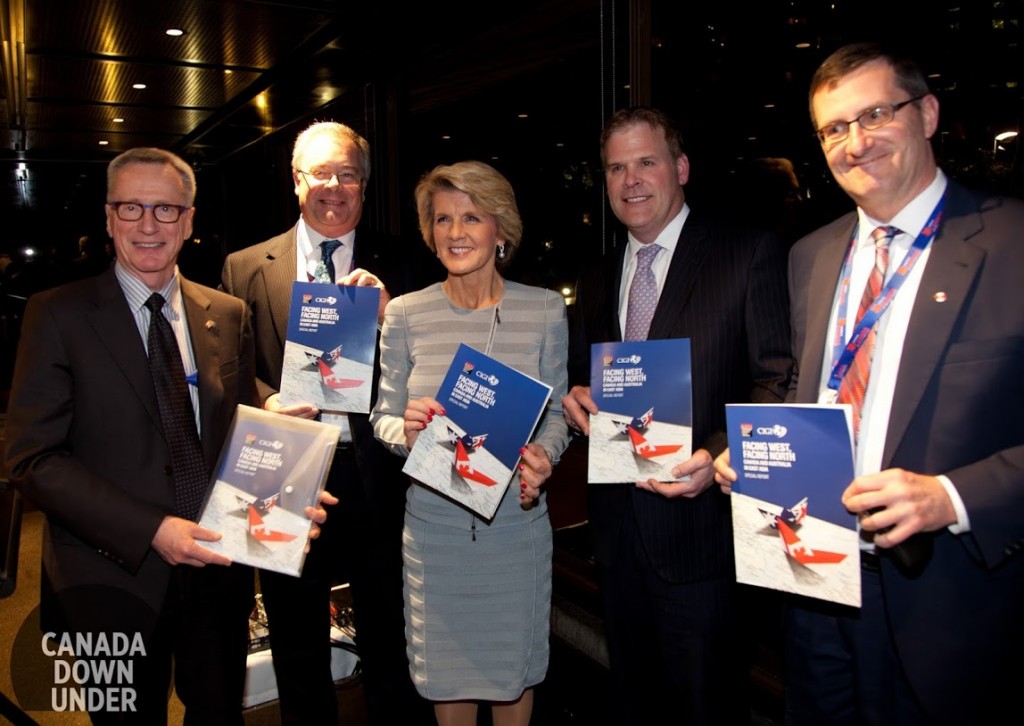The Australia Canada Economic Leadership Dialogue held in Melbourne in late February afforded an important but little noticed opportunity for Prime Minister Tony Abbott to break some new foreign policy ground. Abbott’s speech was reported domestically for its reference to potential domestic spending cuts. Overlooked was his strong statement of intent to deepen the bilateral relationship with Canada:
On a wall in my offices, hangs a painting of a World War One battlefield near Vimy Ridge where Canadian and Australian soldiers had been comrades-in-arms. … These days … we are not so often in each other’s thoughts. …
The commercial relationship is in reasonable shape; but there should be more to our friendship than money. Although John Howard perceptively described Australians and Canadians as kindred spirits, we haven’t talked to each other as often as we should. The relationship is strong but under-developed even though we are as like-minded as any two countries can be. So, I want to make more of this friendship: for our own good and for the good of the wider world.
Abbott surprised his audience by saying that he planned to visit Ottawa this year, the first Australian Prime Minister to do so since 2006. That scrabbling sound you hear, dear reader, is Australian officials looking for ideas to add more substance to the relationship. Based on Abbott’s repeated statement that ‘the Australian Government will say what we mean and do what we say’, we can reasonably expect that ties will be given a boost.
In the defence and security sphere Canberra and Ottawa need look no further than Facing West, Facing North: Canada and Australia in East Asia, the paper ASPI produced in collaboration with Ontario based CIGI, and about which Daniel Grant wrote here. The report was launched at the leadership dialogue, to substantial interest among an audience usually geared to discuss business relations.
In my comments at the launch I noted that there’s a need to close the analytical gulf that separates economists and strategists when they deal with the Asia-Pacific. Economists look at the region and see growth, burgeoning middle classes and ever-closer integration of markets. Strategists, by contrast, see expanding militaries with more complex weapons; elements of arms-racing in North Asia; rising nationalism and hardening approaches to territorial disputes. Both sets of perceptions are correct, but we need to better align perspectives in what’s becoming a more competitive and higher risk Asia-Pacific. In this environment security isn’t a free good. Asia-Pacific growth has been underpinned by the commitment of the United States and its allies. Absent that presence, there’s a risk that the Asia-Pacific would descend into a far more dangerous strategic state. There’d be much higher risks of WMD proliferation, arms racing and conflict.
Australia and Canada share a strategic interest to make sure this deterioration doesn’t happen. Australia’s geography gives us no escape from the realities of our region. Canada has more choice about how deeply it chooses to engage, but the consistent message from the Harper Government is that Canada does see itself as a player in Asia-Pacific security. Ottawa and Canberra need to make some adjustments to better promote this shared reality. Canada needs to look hard at options to increase its military profile in the region. A bigger military attaché presence and a more visible exercise and training presence would help. For Australia’s part, we should acknowledge that there’s value in encouraging that Canadian presence. (Surely in Jakarta we’d value a like-minded Canada helping to smooth our political problems with Indonesia?) Ottawa’s engagement may not translate into acceptance of Canada’s place at the top-tables of regional security forums for some time, but we should encourage Canada to vigorously pursue that objective, demonstrating their credentials with expanded military contact.
In terms of bilateral defence cooperation, the ASPI–GIGI report makes clear that there’s opportunity in frugality—that is, the budget travails of both countries mean there’s an opportunity and a need to look for the benefits of closer collaboration. We should begin by sharing ‘lessons learned’ in defence reform and look for practical ways to copy each other’s savings ideas. There are promising avenues in procurement around maritime systems and vehicles that could benefit both countries. In Service-to-Service engagement we should make sure that long-standing contacts and exchanges reflect current needs rather than their historical foundations.
Finally, we should be working harder to share and align our views on strategic changes in the Asia-Pacific, because a common understanding will be the foundation for closer cooperation. These four steps alone would give Tony Abbott a pocket-full of initiatives to announce when he gets to Ottawa, showing that the bilateral defence relationship can be as much about our shared strategic futures as it is our military past.
Peter Jennings is executive director of ASPI. Photo credit to Consulate General of Canada, Sydney (L. Sullivan).


